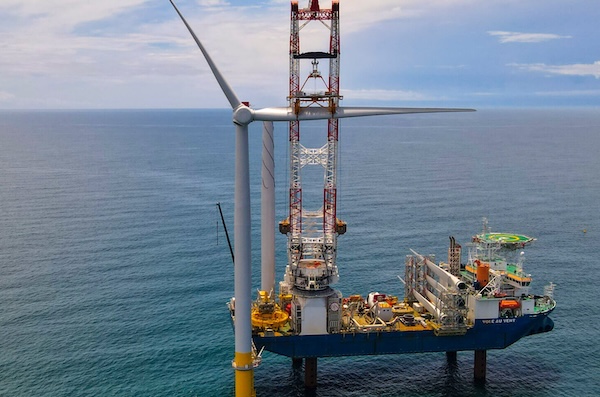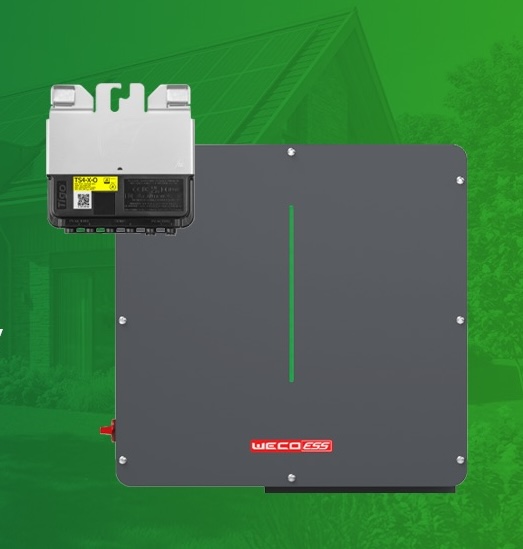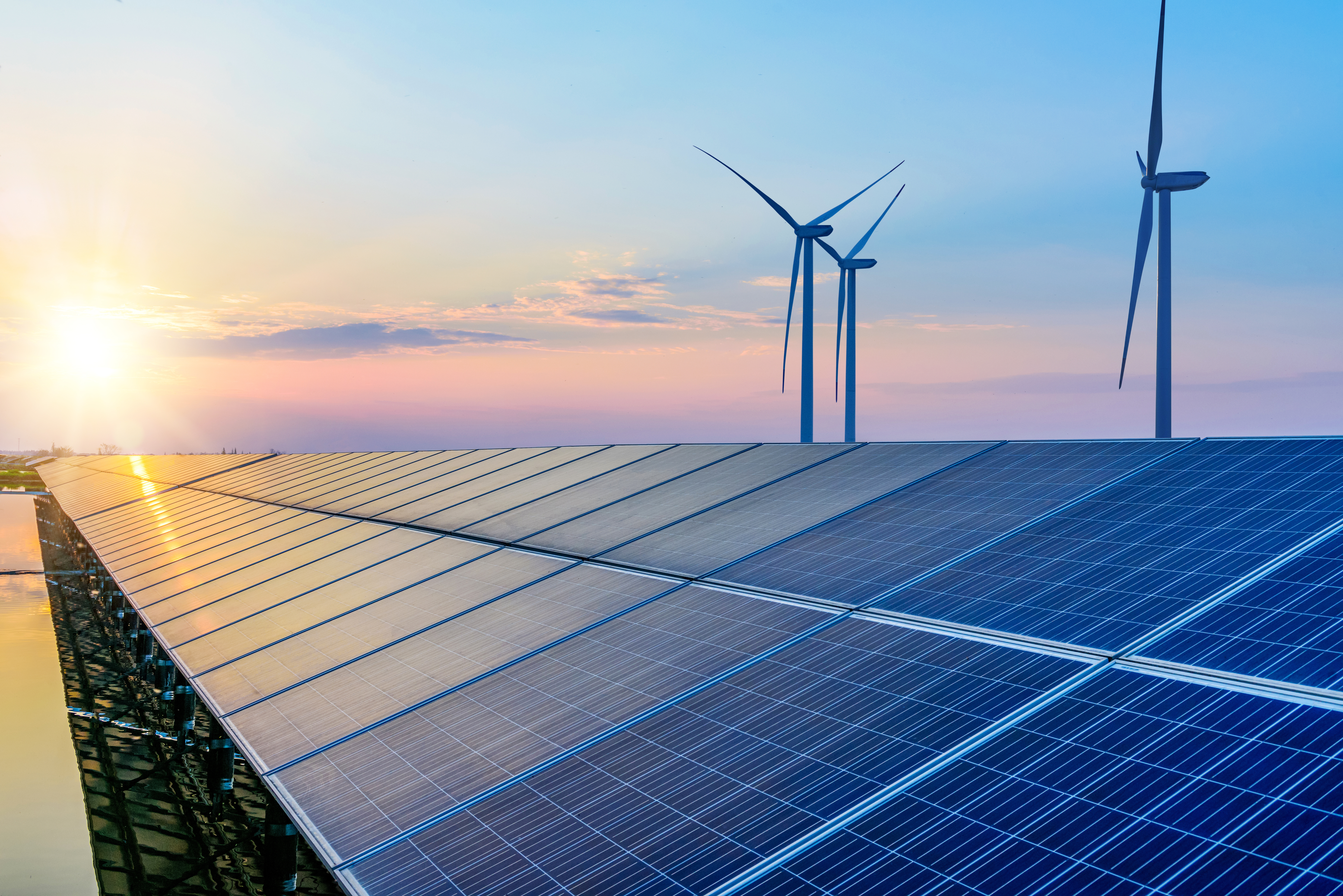Energy Storage
FranklinWH Energy Storage Inc.
Energy Storage
Claude Colp
Energy Storage
TRC Companies

Oceantic Network announced Doreen M. Harris, President and CEO of the New York State Energy Research and Development Authority (NYSERDA), as a keynote speaker for its annual International Partnering Forum (IPF), taking place February 9-12, in New York City. Ms. Harris will address attendees during the offshore energy conference’s Opening Plenary on Tuesday, February 10. She will be joined throughout IPF Week by more than 100 speakers across state government, academia and research, finance and law, emerging technology, and supply chain sectors.
“Successful industry-government partnerships emphasize the critical role offshore wind plays in not only meeting state energy demands affordably and reliably but driving a host of economic benefits for local communities,” said Liz Burdock, President and CEO of Oceantic Network. “States continue to be steadfast partners to Oceantic and bring undeniable value to the industry now and into the future.”
Doreen M. Harris, NYSERDA President and CEO, said, “I look forward to setting the stage for IPF’s dynamic lineup of speakers and kicking off valuable discussions around the offshore wind ecosystem––from ports and projects to supply chain and innovative technology solutions. New York is working to advance an affordable, abundant, reliable, and diverse clean energy future––as demonstrated through New York’s recent announcement of port infrastructure funding and by participating in events like this that provide a crucial forum to share and learn as we collectively chart a path forward.”
A powerhouse lineup of state leaders and industry champions will also be present at IPF, representing a broad contingent of states that are driving the demand for offshore wind, collaborating to advance local supply chains, creating jobs, and accelerating American energy deployment. They include; Will Cox, Vice President Business Development and Investments at Rhode Island Commerce; Celina Cunningham, Deputy Director of the Maine Department of Energy Resources; Katie Dykes, Connecticut Department of Energy and Environmental Protection Commissioner; and Elizabeth Mahony, Commissioner, Massachusetts Department of Energy Resource.
IPF is the premier technical and business conference for offshore wind and marine renewable energy, and this year’s program will feature an expanded focus on emerging ocean-based energy technologies and their alignment with the global offshore wind supply chain. Premier Tim Houston will also address attendees during the offshore energy conference’s Closing Plenary on Thursday, February 12, sharing Nova Scotia’s bold offshore energy vision and the province’s commitment to international collaboration. Notable industry players are sponsoring and attending the conference, including Clarksons, DEME, Flanders Investment & Trade, Latham & Watkins, Massachusetts Clean Energy Center, McAllister Towing, National Grid Ventures, Port of Long Beach, Siemens Energy, Siemens Gamesa, Turn Forward, Waterson Terminal Services, and WindServe Marine.
“I’m excited for IPF because it’s where the ideas, partners, and momentum that shape the future of the ocean economy all come together,” said Will Cox, Vice President Business Development and Investments at Rhode Island Commerce. “Rhode Island has an incredible story to tell in offshore wind and marine innovation, and I’m looking forward to sharing how we’re building the next generation of ocean-tech leadership.”
“I am looking forward to discussing Maine’s offshore wind research and collaborating with neighboring states and partners at IPF,” said Celina Cunningham, Deputy Director of the Maine Department of Energy Resources. “By sharing knowledge through forums like this, we can advance responsible offshore wind development, strengthen energy reliability, and deliver long-term benefits for Maine and the region.”
“Offshore wind remains an important component of grid reliability in New England, and our efforts to make energy more affordable for our ratepayers,” said Katie Dykes, Connecticut Department of Energy and Environmental Protection Commissioner. “It strengthens America’s energy security, grows our economy, and supports local good-paying union jobs. I look forward to this important discussion of best practices, challenges, and possible solutions.”
“IPF brings state policymakers and industry together for meaningful collaboration, and I look forward to the exchange of ideas and discussion around the future of our blue economy,” said Elizabeth Mahony, Commissioner, Massachusetts Department of Energy Resources. “Massachusetts helped lay the groundwork for U.S offshore wind, and the projects that developers want to build can lower costs for our ratepayers and create thousands of jobs and billions of dollars in economic benefits for states.”
2026 IPF - Energy at Sea will convene global leaders, developers, suppliers, and policymakers in New York City, expanding the conversation to include grid and transmission and the broad spectrum of ocean economy sectors, including tidal, wave, and floating solar energy technologies, networking and business development, and strategic dialogue. Exclusive sessions will spotlight state leadership, technical deep dives, and opportunities for collaboration across the offshore wind supply chain. Proceeds from IPF directly fund Oceantic Network’s work to expand the U.S. supply chain and deliver industry-leading, accredited education and collaboration platforms.
For more information about 2026 IPF, including registration details and sponsorship opportunities, visit the conference website. Hotel reservations can be made online under the official room block while availability lasts.
Additional Information:
Attending journalists will have unique access to influential voices right in the heart of New York City. Members of the press can request a complementary pass to IPF here.
Oceantic Network | https://oceantic.org/

A U.S. judge for the Eastern District of Virginia has allowed the Coastal Virginia Offshore Wind (CVOW) project to resume work after granting their injunction request against the administration’s lease suspension and construction pause issued December 22, 2025. Judge Walker granted the injunction because the order was too broad to address the specific project and noted that the risks cited by the government pertained to wind farm operations, not construction. The Administration referenced undisclosed “national security concerns” that arose from a recent classified Department of War study alleging that turbine structures cause interference with military radar systems.
CVOW-Commercial, the largest commercial offshore wind farm in the U.S., is currently 67% complete and set to provide 2,587 MW of power generation to Virginia. The project’s supply chain stretches across more than 27 states and has driven more than $2 billion in domestic supply chain investments. More than 30 vessels, including newbuilds and retrofits from more than a dozen shipyards in Louisiana, Florida, Texas, New York, Wisconsin, Massachusetts, and Rhode Island are supporting the project, including the delivery of the first U.S.-built Wind Turbine Installation Vessel assembled in Brownsville, Texas. The Portsmouth Marine Terminal in Norfolk, Virginia underwent a $250 million conversion to become one of the largest offshore wind ports in that nation. Additionally, CVOW has created more than 2,000 direct and indirect American jobs to date.
In response, Oceantic Network has released the following statement from CEO Liz Burdock:
“The Coastal Virginia Offshore Wind project is critical to securing not only Virginia’s electric grid, but the regional grid serving 67 million residents that depend on the continued, reliable delivery of electricity. Offshore wind stabilizes rising energy costs for local communities, creating jobs and strengthening our energy independence, underscoring the importance of building America’s energy infrastructure to meet rising electricity demand. The U.S. offshore wind industry has always worked closely with the federal government to ensure national security interests were prioritized in the siting and permitting of every project in federal waters. Oceantic applauds this result to get the project moving again to deliver reliable, affordable power and good-paying jobs to communities across the region that desperately need it.”
There are significant economic consequences associated with pausing the construction of the five U.S. projects during installation:
This latest ruling follows recent industry court victories against the administration’s attempts to slow down offshore wind. This week, Empire Wind and Revolution Wind were allowed to resume work after injunction requests were granted against the administration’s lease suspension and stop construction order issued December 22, 2025. In December, a federal judge vacated the Administration’s previous permitting pause, ruling it unlawful. Sunrise Wind (924 MW) and Vineyard Wind 1 (800 MW) are still subject to the construction pause and lease suspension. Both have filed complaints to challenge the Order and await court hearings.
Oceantic Network | https://oceantic.org/

The Zero Emission Transportation Association’s Executive Director, Albert Gore, issued the following statement in response to the news that Canada has reached an agreement with China to lower tariffs on Chinese-made electric vehicles:
“One in four new passenger vehicles sold in 2025 were electric. Today’s announcement that our friends in Canada have reached an agreement with China to lower tariffs on Chinese-made electric vehicles, along with the previous announcement of a similar deal between China and the European Union, shows that the global automotive market’s interest in electric transportation remains strong. While each entity is entitled to negotiate trade deals in its own interest, this dramatic shift in policy shows that the United States’ auto policies are out of step with the global market and risk harming future American technological dominance and American jobs.
“Electric vehicles are great products and popular with drivers. If the United States does not invest in them, our global competitors will. This is why it is so critical that we continue to invest in the electric vehicle and battery supply chain here at home.”
ZETA | https://www.zeta.org/

Tigo Energy, Inc. (NASDAQ: TYGO) (“Tigo” or “Company”), a leading provider of intelligent solar and energy software solutions, announced the Company has signed a certificate of compatibility with Weco S.r.l., documenting the compatibility between Tigo Flex MLPE products and hybrid solar inverters from Weco. The certification covers certain single-phase and three-phase Weco products and members of the Tigo TS4-A and TS4-X product families, when properly designed and installed. Together, these products are designed to deliver high-quality, enhanced value through a system that generates and manages solar energy more efficiently and delivers the features residential energy customers demand.
“The compatibility between our inverter solutions and Tigo optimizers represents a significant step forward for the entire industry, and confirms our commitment to simplifying the work of solar professionals,” said Federico Cusumano, R&D manager at Weco S.r.l. “Thanks to this certification, designers and installers can now benefit from greater sizing flexibility to optimize system configurations according to the precise requirements of each customer site. Together, Weco and Tigo are delivering a more integrated, intelligent energy ecosystem focused on long-term value for the end customer.”
The use of Tigo MLPE technology with hybrid inverters, such as those provided by Weco, enhances overall solar performance, particularly in installations that include partial shading, module mismatch, or constraints inherent to residential rooftop architecture and layout. With optimization from Tigo, solar systems become more efficient, versatile, and capable of delivering stable energy production even under non-ideal conditions. Tigo and Weco will host a joint webinar where installers can gain deeper insight into the two companies' product portfolios and explore real-world case studies that demonstrate how the technologies work together.
“For Tigo, this announcement is first and foremost about giving installers greater control at the module level without adding complexity to system design,” said Gal Bauer, senior director of validation, growth, and product management at Tigo Energy. “Certified compatibility with Weco inverters ensures that Tigo Flex MLPE technology can be deployed exactly where it delivers the most value, while maintaining a smooth commissioning process and predictable system behavior. This is yet another concrete example of how Tigo continues to build an open ecosystem that prioritizes safety, flexibility, and long-term system performance.”
A complete list of Weco products certified for use with Tigo MLPE products is available at the Tigo MLPE compatibility page, here. Installers are invited to sign up for the joint technical webinar with Tigo and Weco representatives here, scheduled for Thursday, Feb. 5 at 4:30 p.m. CET. Information about the Tigo TS4 range of Flex MLPE can be found on the Tigo product page, and commercial inquiries can be made via the sales contact form, here.
Weco | https://wecobatteries.com/
Tigo Energy | www.tigoenergy.com

For more than 80 years, TAMKO has built its reputation by doing what it says it will do: standing behind its products, supporting contractors, and protecting homeowners. Today, that long-standing commitment continues as TAMKO announces its strategic alignment with the Roofing & Solar Reform Alliance (RSRA) and industry advocate Adam Bensman.
This alignment reflects not a new brand direction, but the culmination of focused development over the last five years, marked by the rollout of high-performance products like Titan XT and StormFighter FLEX shingles, the expansion of The TAMKO Edge contractor program, and continued investment in innovation, transparency, and contractor support.
Focused on mutual benefit – serving homeowners, empowering contractors, and strengthening communities, TAMKO’s alignment with RSRA reinforces a belief that has guided the company for decades: integrity matters, transparency builds trust, and protection goes beyond the roof. “At TAMKO, commitment isn’t a slogan; it’s how we operate,” said Alex Hines, Vice President of Sales and Chief Revenue Officer. “We are intentional about supporting contractors, protecting homeowners, and strengthening the communities we serve. Adam Bensman and RSRA share those same values, and this alignment reflects our shared belief that transparency and accountability are essential to the future of our industry.”
Founded on the principle of Fighting for What’s Right, RSRA has become a respected voice for reform advocating for collaboration fair treatment of contractors, ethical business practices, and providing exceptional service to protections for homeowners navigating roofing and solar projects.
“It’s crystal clear that TAMKO’s values and commitment to excellence in both relationships and product development are focused on homeowners and contractors, not just shareholders,” said Bensman. “TAMKO has a long history of standing with contractors and investing in the long-term health of the industry. We share the belief that homeowners come first and that trust, accountability, and transparency are what will keep this industry strong.”
As a privately held, independent manufacturer, TAMKO understands that being smaller means trying harder. That mindset drives the company to innovate not only in products, but in programs and processes designed to help contractors protect their reputation, reduce call-backs, and deliver on their promises to homeowners.
As part of this effort, TAMKO and RSRA will collaborate on industry education, advocacy initiatives, contractor outreach, and public awareness efforts that strengthen trust across the industry.
This announcement underscores TAMKO’s brand promise Performance that Protects - delivered through products that perform as promised, programs that support contractor growth, and leadership guided by integrity.
TAMKO Building Products | www.tamko.com

The National Electrical Manufacturers Association (NEMA) expanded its Make It American domestic content certification program to include a product specification for Electrics. Electric motors are present in all aspects of daily life, powering fans, pumps and compressors in appliances, computers, HVAC systems, vehicles, and manufacturing operations.
NEMA’s Make It American program empowers the market to identify products and manufacturing facilities that meet best-in-class processes and standards to achieve domestic content requirements. Through rigorous third-party audits, participating companies verify that their facilities, processes, products, and supply chain management systems meet the requirements of the Build America, Buy America (BABA) Act.
Today, companies can certify their facilities to NEMA’s Make It American Process Standard and their products across seven categories using NEMA’s BABA Product Specifications – including NEMA’s BABA Product Specification for Electric Motors.
“The electroindustry is on the front lines meeting the nation’s rapidly increasing energy needs and driving economic growth,” said NEMA President and CEO Debra Phillips. “Our economy relies on strong domestic supply chains to drive that growth, including electric motors that underpin industrial production, grid-connected infrastructure and modern technology. Expanding NEMA’s federally recognized Make It American program to include motors supports bolstered U.S. manufacturing of a technology critical to energy reliability, resilience, and security.”
Electric motor systems convert approximately 50 percent of all electricity into mechanical energy for driving modern society. Electric motors are used across the economy — running HVAC systems in buildings, moving water through drinking water and wastewater facilities, supporting advanced manufacturing, powering key parts of the electric grid, and enabling electric vehicles.
Like the BABA Product Specifications for Variable Frequency Drives, Grid Management & Automation technologies, and other electrical products, the BABA Product Specification for Electric Motors meets increasing U.S. market demand for the technologies at the center of the effort to meet unprecedented demand for electricity.
"ABB is excited to see NEMA's Make It American certification program recognizing the vital role electric motors play in supporting the U.S. jobs and supplying essential components for critical infrastructure," said Benjamin Hinds, Executive Vice President of Product Management at ABB. "This standard simplifies the process for customers to identify motors that meet domestic content requirements, helping strengthen U.S. manufacturing".
Both NEMA’s Make It American Process Standard for facilities and NEMA’s seven Product Specifications provide greater certainty and confidence to manufacturers, government agencies, and procurement officials seeking to source materials with enhanced levels of U.S.-manufactured content. To date, 10 companies have certified at least one facility to NEMA’s Make It American Process Standard. Read about the program’s expansion and growing list of participants, here.
NEMA’s Make It American Certification Program identifies facilities and products that have undergone a rigorous, independent third-party supply chain evaluation to support domestic content requirements, providing certainty to customers and promoting investment in energy infrastructure made here at home. In October 2025, the U.S. Federal Highway Administration (FHWA) listed the NEMA Make It American program as an official industry resource guiding manufacturers through federal domestic preference requirements for infrastructure projects receiving federal funds.
National Electrical Manufacturers Association | makeitelectric.org

A U.S. judge in D.C. court has allowed Empire Wind to resume work after granting their injunction request against the administration’s lease suspension and stop construction order issued December 22, 2025. Despite the government’s argument that new national security concerns from a recent classified study prompted the action, District of Columbia Judge Nichols granted the injunction because of the lack of notice given to the project before the order was issued and the successful demonstration of irreparable harm to the project. Together, these outweighed the Government’s claim of the potential risk to public safety interests during construction, citing Natural Resources Defense Council v. Winter, 8:07-cv-00335. Additionally, the judge noted the Administration failed to respond to most of Empire Wind’s claims, nor did they contest that the construction pause was an arbitrary and capricious action.
Empire Wind 1, which is currently 60% complete, is set to provide 810 MW of power generation to New York and has created more than 2,000 jobs to build the South Brooklyn Marine Terminal, sparked investments, and kindled the construction of at least eight new vessels from Pennsylvania, Louisiana and Mississippi shipyards. To build this project, the developer purchased export cables from a South Carolina factory and cable components from Upstate New York that prompted the construction of a new factory—microcosms of a supply chain that stretches across 30 states. Coastal Virginia Offshore Wind-Commercial (2,586 MW), Sunrise Wind (924 MW), and Vineyard Wind 1 (800 MW) are still subject to the construction pause and lease suspension.
In response, Oceantic Network has released the following statement from CEO Liz Burdock:
“Oceantic welcomes today’s ruling that allows Empire Wind to once again advance toward delivering reliable, affordable power to 500,000 homes and supporting good-paying jobs to communities across New York. Empire Wind is critical to securing New York’s electric grid, stabilizing rising energy costs for local communities, creating jobs, and achieving energy independence, underscoring the importance of building out America’s energy infrastructure to meet rising electricity demand.”
There are significant economic consequences associated with pausing the construction of the five U.S. projects during installation:
This latest ruling follows recent industry court victories against the administration’s attempts to slow down offshore wind. Just days ago, a federal judge allowed Revolution Wind to resume work after granting their injunction request against the administration’s lease suspension and stop construction order issued December 22, 2025, citing a lack of urgency to resolve the security concerns which didn’t indicate an emergency suspension was necessary. In December, a federal judge vacated the Administration’s previous permitting pause, ruling it unlawful.
Oceantic Network | https://oceantic.org/
Alternative Energies Jan 16, 2026
2025 was a roller-coaster year for US renewables. The economic landscape for the sector, which had already been shifting over the last couple of years, has changed significantly. The phase out of financial support from state and federal governments, ....



The year ahead may reward companies that aren’t built on government incentives alone. Quality, service, and lean operations will define the winners. The renewable energy sector has weathered uncertainty before, and 2025 was no exception as gov....
The solar industry’s rapid evolution is a story of innovation, fierce competition, and dramatic exits. As countries move toward decarbonization and grow the share of renewable energy in the total energy mix, the commercial solar panel sector has se....
Utility-scale solar plants are under mounting pressure to deliver maximum energy output while meeting strict performance guarantees. This pressure is reshaping the role of irradiance monitoring, where precision now directly affects a project's financ....
In the wind industry, building sustainab....
Barbados has taken a decisive step towar....
As more consumers consider electric vehicles (EVs), professionals have a critical role in helping homeowners understand what it truly means to be ready for home charging. Since U.S. EV credits expired in the fall of 2025, the conversation around EV a....
On sweltering summer evenings, with millions of A/C units running simultaneously, grid stress rises fast, heightening the risk of outages. Increasingly today, the solution to those rolling blackouts is not bigger power plants: the humble home battery....
When industry professionals discuss BESS equipment, conversations naturally gravitate toward battery chemistry, inverter technology, and software controls. But one of the most critical components determining long-term BESS project performance, effici....
2025 was a roller-coaster year for US renewables. The economic landscape for the sector, which had already been shifting over the last couple of years, has changed significantly. The phase out of financial support from state and federal governments, ....
We ask a lot of drones today, between monitoring for fires, delivering aid, securing borders or even rebuilding communications after disasters. Yet their biggest limitation remains the same: endurance. Most spend hours recharging or waiting for ....
Modernizing the electric grid involves more than upgrading control systems with sophisticated software—it requires embedding sensors and automated controls across the entire system. It's not only the digital brains that manage the network but also ....